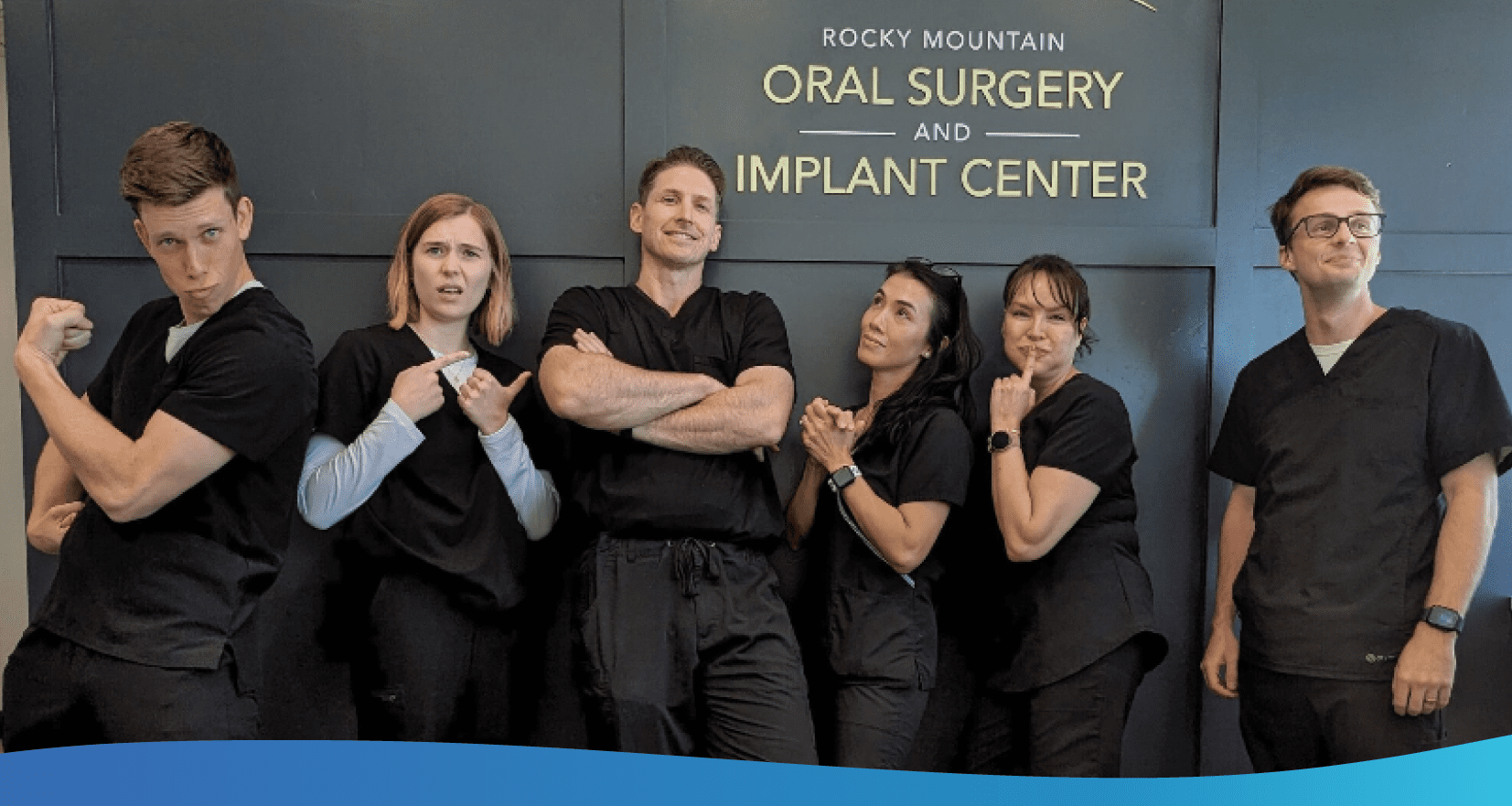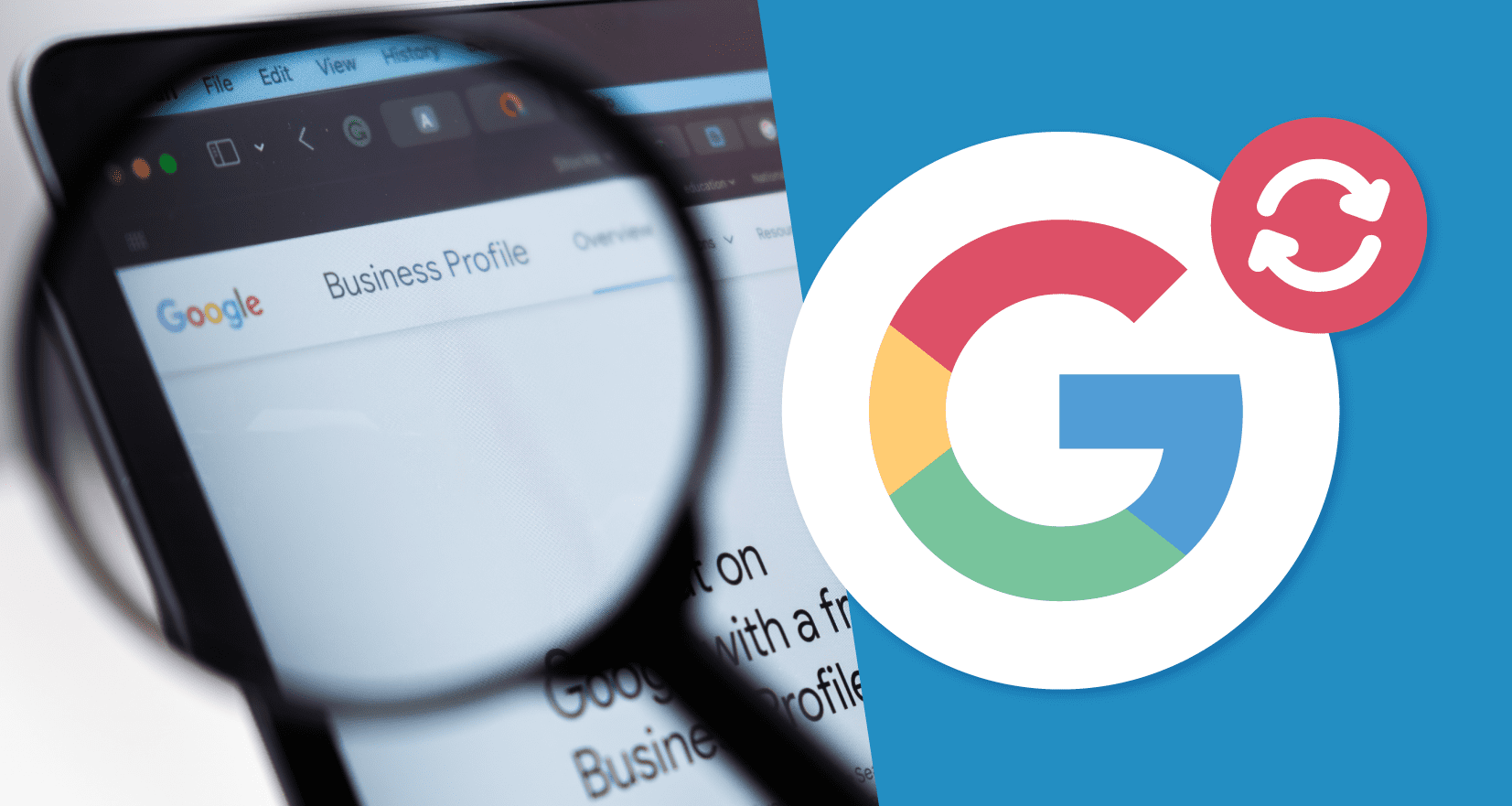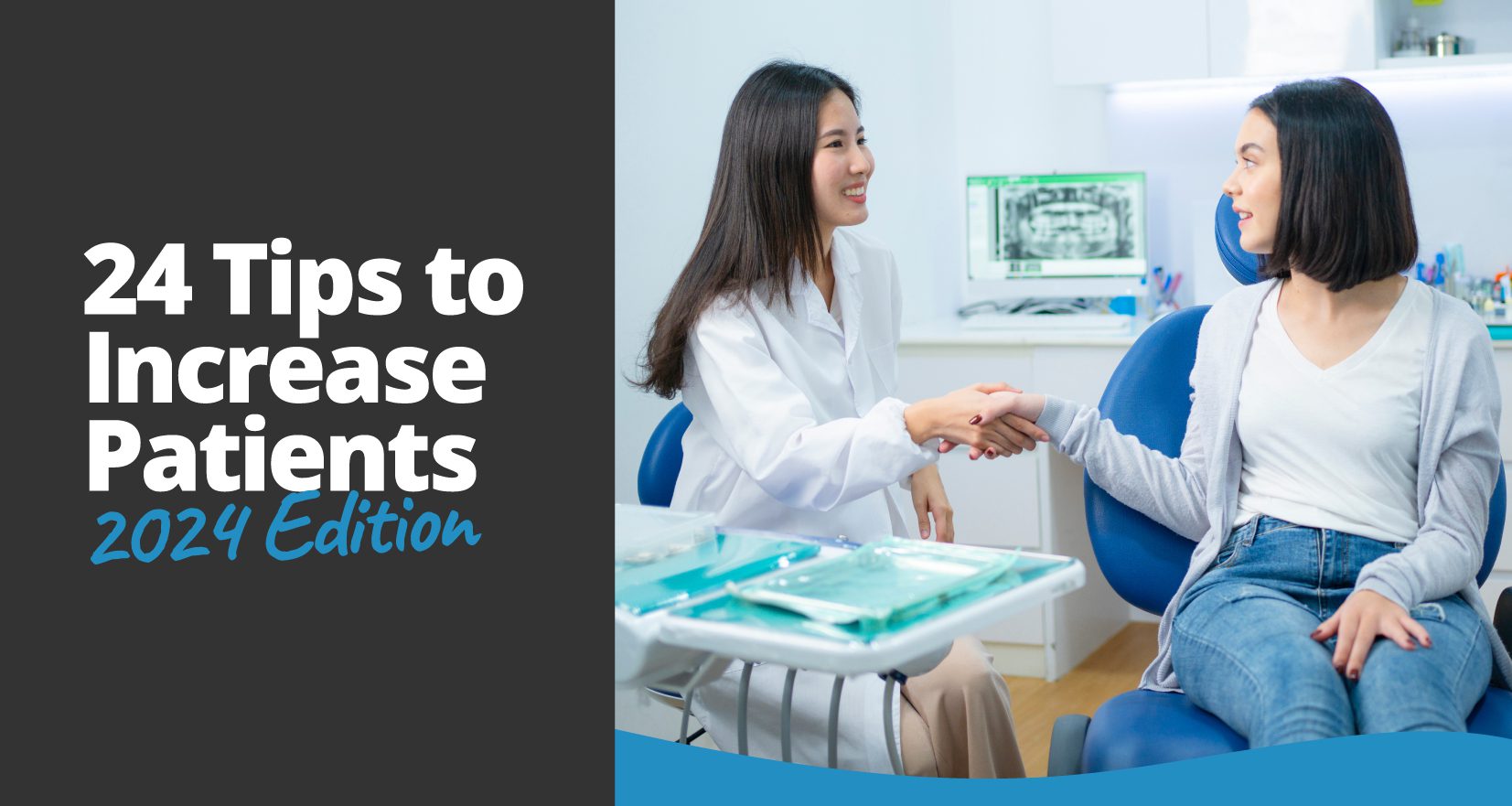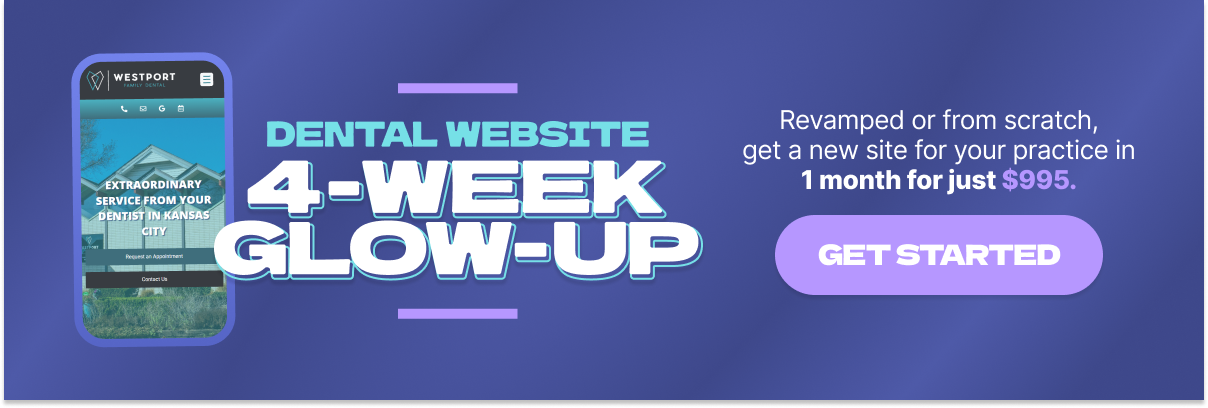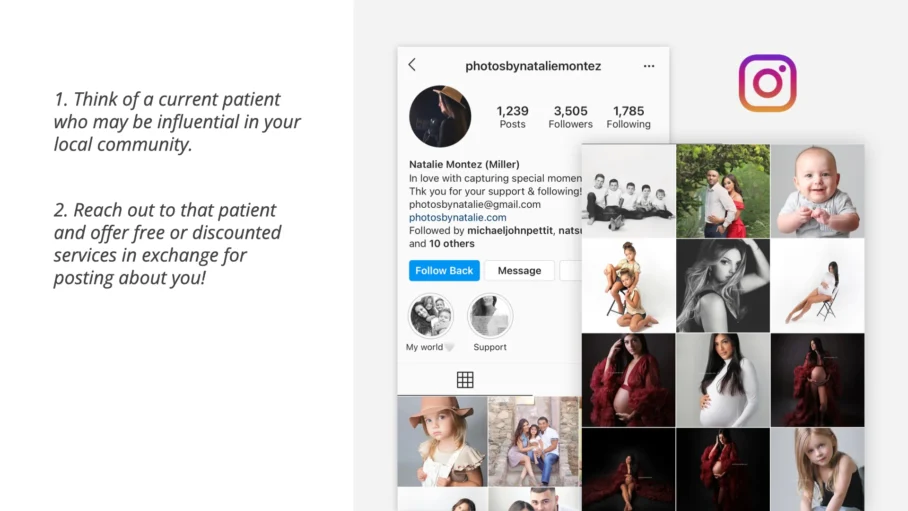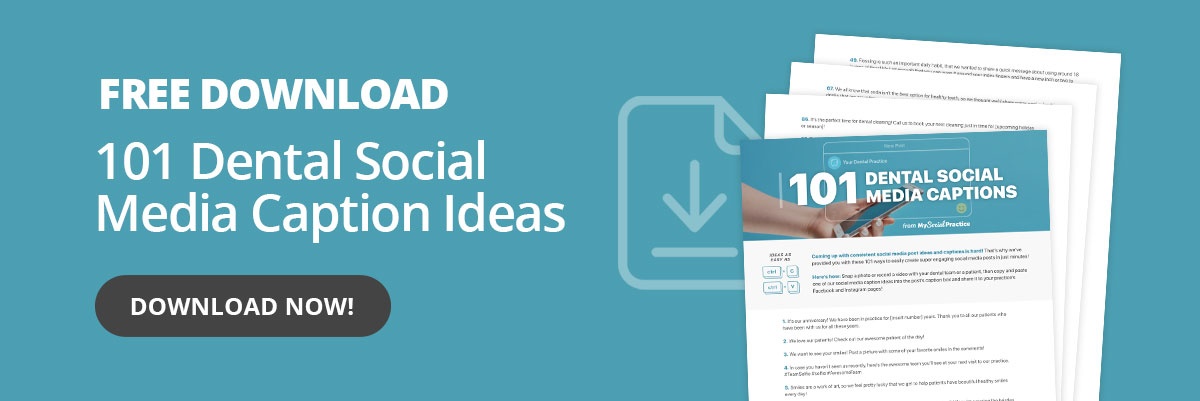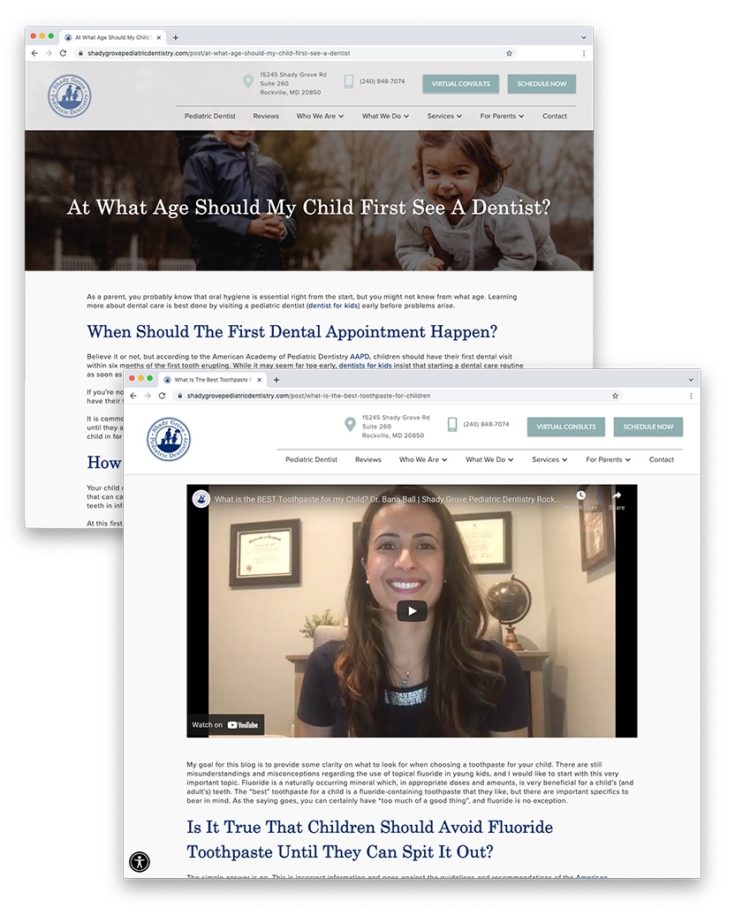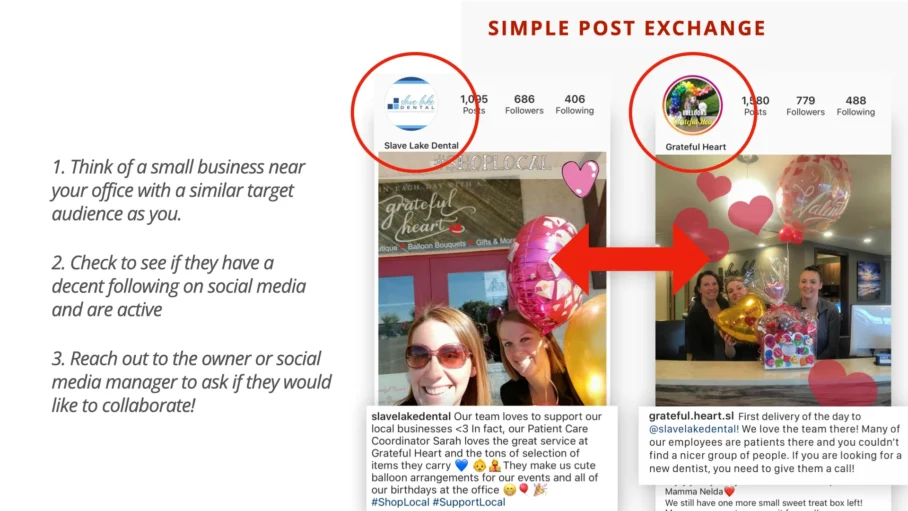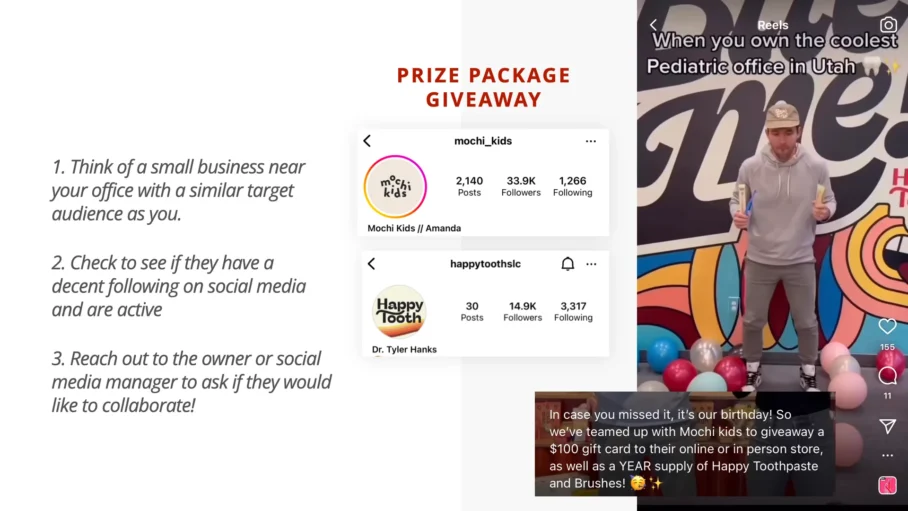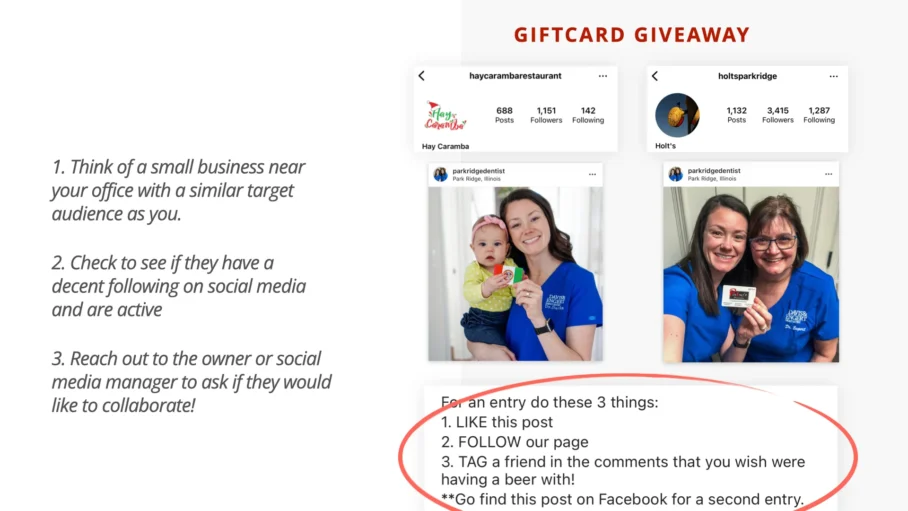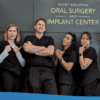Marketing for Dentists: Essentials of Digital Dental Marketing
Attracting new patients and being found online are competitive tasks in today’s digital marketing world. It’s not about attracting any type of patient; you want to attract patients for the most profitable cases. It’s a complex task!
Successful digital marketing for dentists requires a sophisticated strategy, time and effort; most practices need more time to spare for marketing initiatives.
The digital marketing landscape changes quickly and this year we’ll see some big changes. With TikTok becoming a serious player, the launch of Local Service Ads for dentists, and the inevitability of artificial intelligence being used in marketing, there is a lot to learn.
Your team member in charge of dental marketing should understand the digital marketing landscape and how the online opportunities work together to create a cohesive dental marketing strategy.
No time to waste; let’s get started learning about ways to improve your dental marketing campaigns.
Table of Contents
- Rank Higher on Google Maps
- Add Social Profile Links to your Google Business Profile
- Leverage Video in Dental Marketing Campaigns
- Post to Instagram Reels
- Update to a Modern Dental Website Design
- Optimize your Website for Technical SEO
- Leverage Local Social Media Influencers
- Update Your Practice’s Mission Statement
- Attend the Digital Dental Marketing Conference
- Take Advantage of Dental Social Media Platforms
- Use Instagram Threads
- Start a Dental Blog
- Get More Google Reviews than your Competition
- Respond to Every Patient’s Google Review
- Do Good with Charity Dental Marketing
- Bump Up Your SEO Rankings with a Blog Post Exchange
- Prize Package Give-a-way Collaborations are Awesome!
- Reach a New Audience with a Gift Card Give-a-way
- Update Your Website to New HIPAA Compliance Requirements
- Get Comfortable using AI
- Remind your Patients about Dental Benefits Before They Expire
- Find Your Value Proposition and Use it In Your Marketing
- Convert More Website Visitors with Live Chat
- Outsource as Much Marketing as You Can
- Frequently Asked Questions
1. Rank Higher on Google Maps
For local dental online marketing, a Google Business Profile (GBP) is required. A GBP listing shows up in the Google maps section of SERPs (Search Engine Ranking Page). Each GBP shows your address, business hours, phone number, website, reviews, and average review rating, making it easy for the person searching to decide on calling your office. Ninety percent of worldwide searches are on Google. An optimized Google Business Profile is a substantial new patient opportunity that most dentists need to be aware of.
How a Dentist can Rank Higher on Google Maps?
When a potential patient searches for a dentist online, they’ll get the Google Map 3-Pack in the search result. The Google Map 3-pack are the top three listings on the Google map. It’s a big deal to be listed in the Google Map 3-Pack. Our own dental marketing case studies have shown that it can double and sometimes triple your new patient phone calls.
When you optimize your GBP listing, you’ll rank higher on the Google map and at a wider radius. Patients further away will see your GBP listing. Essentially you’ll be out-ranking practices that are located closer to the person searching.
Your practice GBP is free to set up. If you’ve never accessed your GBP profile, you can learn how to with this dental SEO training video. I created a dentist marketing video explaining how to get started. Check out the marketing video here.
What Happens if you Don’t Optimize Your GBP Listing?
You’ll get your lunch eaten by the dental practice down the street.
Patients will search for a dentist near them, and even if you’re the closest practice, you won’t be on the first page of search results. It’s true. Your practice could be just down the street from a patient searching “emergency dentist near me,” and practices that are further away will show up higher on the map. It’s not that your practice listing isn’t there; it’s just buried deep in the results.
Thousands of consumer online search studies have shown that more than 90% of people choose a result on the first page of SERPs. The practices listed on the first page are the ones that get the lion’s share of new patient phone calls.
We recently recorded a dental marketing training video to help your dental marketing manager get through some of the most challenging parts of Google maps optimization. You can watch the dental marketing video here.
2. Add Social Profile Links to your Google Business Profile
Along with optimizing your Google Business Profile to rank higher on Google Maps (find out how your practice ranks on Google Maps here), you can also include links to your practice’s social media profiles. Adding social links to your dental GBP helps patients look into your practice and get a better idea of what to expect before their first visit.
To add social media links to your GBP, first, access your account either through the Google Maps app on mobile or through your desktop portal. From there, you can select “edit profile,” then “business information,” and then “contact.” Under the contact section, you’ll find “social profiles,” where you have the option to choose which platforms you want to display. These results will then show up right next to your practice’s name in a Google search or Google Maps search.
3. Leverage Video in Dental Marketing Campaigns
You can create all the photos and articles you want, but if you’re not venturing into dental video marketing, you’re only scratching the surface of what online marketing can do.
Consider this: about 68% of online consumers prefer watching a video about a new service or project over learning about it any other way. The amount of online video content that people view has almost doubled since 2018. And 92% of marketers say that video content is vital to their marketing strategy.
The type of dentist video content changes from one practice to another. There are numerous applications across your dental digital marketing strategy. Here are a few ideas to start:
- Pair the video with your email marketing. Some research shows that adding a video link to a promotional email can increase your click-through rate by up to 80%. This can be especially useful if you’re featuring a new service or sending personal holiday greetings from your team.
- Create brief informational videos. Answer frequently asked questions. Show a demonstration of dental service. Shoot a day-in-the-life video. Provide close-up views of equipment.
- Use video on your dental website or a landing page to familiarize visitors with your team. Doing so will bridge the gap between online research and that first visit to your office.
- Share fun videos on social media that help people feel like they’re in touch with your team. Check out these viral TikTok video ideas.
- Invest in professional video production to create a beautiful introduction to your practice. Utilize footage and produce full-length videos and short promos that you can use in ads on YouTube, TikTok, Instagram, and Facebook.
- Encourage and incentivize user-generated content. Challenge patients to submit their own content by setting up a video hub in-office. Ask your patients quick questions and encourage client testimonials.
- Feature a smile makeover. Utilize the power of visuals to illustrate your restorative and cosmetic services.
If you are nervous about being on video, you’re not alone! Even people who comfortably lecture in an auditorium full of professionals can freeze up as soon as they know a camera is on them.
Here’s the good news: It gets easier the more you do it! If you can create a habit of dental marketing video production, you’ll notice less and less resistance each time. That’s why a series can be so helpful.
If you still need help with video content in your practice? Check out our Instagram story ideas or our guide to TikTok for dentists.
4. Post to Instagram Reels
While you’re focused on making videos for your marketing materials, don’t forget about Instagram Reels. This addicting video feature on one of the biggest social media platforms in the world is perfect for bringing awareness to your practice and showing off your best qualities.
Currently, Instagram Reels for dental practices include up to 90 seconds of video, but the platform may roll out an option for 10-minute Reels to the public in the near future. If you need help getting started, check out our free Intro To Social Video eBook.
5. Update to a Modern Dental Website Design
A modern, comprehensive website is the cornerstone of strategic marketing for dentists. First impressions matter tremendously; if your dental website design looks like it came from the stone age, you’ll want to upgrade it now.
Your website design creates a perception of the quality of your care. If it’s modern and well-designed with top-of-the-line functionality and aesthetics. In this case, a visitor will think the same about your dental skill. Beyond aesthetics, a dental website should be organized and function technically well, improving visitor experience and increasing rankings and conversions. Adding custom information about your practice, services, and resources increases the chance of your practice ranking higher on Google maps.
Consider the following in a new dental website design:
6. Optimize your Website for Technical SEO
Often overlooked are the technical aspects of a dental website, but not by Google.
Google wants the consumer experience to be flawless. If your website loads slowly, has broken links, needs to be more secure, or is not mobile optimized, you’ll receive lower rankings in the search engines. Grade your website to see if it’s technically proficient.
Healthy marketing for dentists’ campaigns requires that the technical aspects of a dental website are up to snuff.
- Check the speed of your dental website: In today’s fast-paced world, website visitors have zero patience. If the page loads too slowly, visitors bounce. Your bounce rate impacts search rankings positively or negatively. First impressions count; unfortunately, being sluggish is not good. You only have three seconds for a page to load before 40% of your potential patients click the back button.
- Ensure your website is secure and HIPAA compliant: Security is a no-brainer in healthcare. If your website isn’t HIPAA compliant, you expose the practice and the clients to fines from the OCR. Being fully secure is a requirement for HIPAA, especially if you have contact, request appointment forms, and payments through your website.
- Confirm your dental website is mobile optimized: More people use mobile devices to search online than searches on a desktop. A mobile-optimized website is a must. Google implemented a mobile-first index which means you’d better ensure your site is mobile-optimized; otherwise, you’ll receive lower rankings.
- Is your website coded properly for SEO? The most successful dental practice websites are correctly built and coded for SEO. SEO is a digital marketing strategy that helps Google read and rank your website for the search phrases (keywords) that are most valuable to your practice. Getting into SEO is close to opening pandora’s box. It feels like a never-ending graduate mathematics class where the basic rules of math change willy-nilly. Well, not that bad, but close. But don’t let me scare you from moving forward with an SEO strategy. SEO is one of the least expensive and most effective ways to be found by patients who are ready to schedule. To learn more about dental SEO, read SEO dental industry articles and follow SEO online publications.
7. Leverage Local Social Media Influencers
One of the best ways to find new patients in your area is by leveraging the power of local social media influencers. Instagram marketing for dentists is most successful when you create a variety of engaging content on your platform, and incorporating influencers is a perfect way to mix things up.
An influencer is someone with a large social following (at least 1,000 followers) who endorses products and brands alongside their everyday content. Technically, if someone has less than 10,000 followers they can be considered a “micro-influencer,” but as long as they have the attention of people in your community, they can be a super valuable asset. In fact, dental influencer marketing is usually much more effective than traditional advertising, because potential patients already trust and value the opinion of these semi-public figures.
In order to reach your target market, choose someone local to become a dental influencer for your practice. This person could even be a current patient with influence in the community like a photographer, personal trainer, musician, or blogger. Reach out and see if they’d be willing to make a video about their next dental visit and tag your practice, or ask if you can partner with them for a giveaway. In return, you can offer them free dental work, discounted products, or other incentives.
Play it safe and download this free Influencer Agreement Template once you’re ready to begin your collaboration. This way you can lay out the roadmap for your partnership, comply with FTC regulations, and get any discounts or promotional offerings in writing.
8. Update Your Practice’s Mission Statement (and make sure it’s on your website)
Once your dental website is updated to a modern design and running smoothly with technical SEO (download this eBook if you need more SEO help), you can focus on the text on your website—especially on your home page. The home page of your website provides a first impression to potential patients, and a mission statement can help them understand your practice better.
Create a dental practice mission statement by honing in on your values, goals, and purpose. You can even feed your mission statement to ChatGPT and ask it to make it more concise or fit a specific tone.
9. Attend the Digital Dental Marketing Conference
When you feel like you’ve exhausted all your ideas and are unsure what step to take next, it may be time to expand your skills, explore what’s possible, and cement new professional connections by attending a dental marketing conference!
Dental conferences are a great place to find resources dedicated to marketing for dentists. You can also attend a general small business marketing conference and translate those suggestions into action items for your practice. Conferences, seminars, and local networking events can be beneficial as you expand your community connections and resources.
However, we highly suggest looking into a conference that is specifically tailored to digital marketing for dentists. Dental practices occupy a unique business position, necessitating small business know-how and professional medical expertise. As such, your marketing needs, techniques, and considerations aren’t the same as other small businesses. A dental-focused marketing conference will zero in specifically on your concerns and maximize your ability to make the most of every hour.
Benefits of attending a dental marketing conference:
- Meet other marketing managers and swap practice tips and tricks.
- Seminars offer hands-on experience from photography to dental Instagram marketing, smoothing the hurdles of figuring things out for yourself the first time.
- Get inspiration from other practices, so you can return to work with fresh eyes and new enthusiasm.
- Stay up to date on the trending strategies. Digital marketing moves fast, and investing your time in outdated approaches won’t get you the desired results.
- Meet dental marketing experts who will advise on trending marketing tips and strategies.
Where can you learn about upcoming dental marketing conferences? We host the dental digital marketing conference each year.
10. Take Advantage of Dental Social Media Platforms
All digital dental marketing campaigns should include setting up and maintaining active social media accounts. Social media helps your practice stay in ongoing contact with current and potential patients in your community.
When you learn how to produce good content that gets lots of engagement, you’ll find social media to be one of the most valuable strategies in dental marketing.
Leveraging social media tools doesn’t require big budgets like traditional advertising or online paid advertising. However, it does require some time and training to understand how to create compelling and engaging content.
The best place for social media ideas is to subscribe to My Social Practice’s blog. We are constantly coming up with super-cool ideas that you and your team can easily do. We also provide case studies that show dental practices succeeding at social media marketing.
Which Social Media Tools Should A Dental Practice Use?
After helping thousands of practices run effective social media campaigns, we’ve learned that using the right tools is essential.
Instagram: Instagram is owned by Facebook and was built as a mobile photo-sharing app. Over the years, it has added functionality to the point that it’s one of the best ways to advertise and market a dental practice.
The average age demographic of Instagram is younger than Facebook. So if you’re trying to reach mothers with small children, Instagram fits that demographic.
Instagram has a unique marketing opportunity with influencers. Instagram influencers are people who have followers that trust their opinion about brands and products. We’re not talking about influencers with millions of followers. We’re talking about micro-influencers.
Micro-influencers are people on Instagram with less than 10,000 followers. The followers of a micro-influencer are likely located in the influencer’s geographical area, making them a great dental marketing opportunity.
The first place to look for a micro-influencer is among your current patients.
TikTok: TikTok has taken the social media world by storm. It’s grown faster than any other social media application and doesn’t look to be slowing down.
If you have yet to be on TikTok, I’m encouraging you to do so. But before you get started, make sure to get an accountability coach. A person who will take your phone away when you’ve crossed the way-too-much-TikTok-for-today-line.
Once you’re on TikTok, follow some of the trending TikTok dentists. When you see how other dentists are using TikTok to grow their practices, you’ll get ideas about implementing it into your digital marketing campaign.
Facebook: Although it seems ancient in social media, it isn’t going away. If anything, it’s evolving.
You must remember that Facebook has more people using the software than any other social media platform. Facebook needs to be part of your marketing plan if you’re trying to reach your local audience.
One of the benefits of Facebook is the direct messaging function. Someone on your team should manage the direct messages from Facebook. Direct messaging is nearly as important as your practice telephone. If you don’t have a team member to do this, consider hiring someone to do it for you.
Humanizing your practice with Facebook will create feelings of trustworthiness. It’s like being part of a family. And isn’t the ultimate goal to have a large dental family?
11. Use Instagram Threads
Another social media platform your dental practice can try is Instagram Threads. This app launched in 2023 as an alternative to X (formerly known as Twitter). After a rocky change in ownership, X has been losing users left and right, and new platforms have been clamoring to replace this coveted spot on the home screen. When Meta (owner of Facebook and Instagram) threw its hat into the ring with Threads, it gained 30 million downloads overnight.
Your dental practice can take advantage of this large network of people by posting regularly on Threads. Users can post up to 500 characters, 10 images, and 5 minutes of video in one post.
12. Start a Dental Blog
I just heard the air leave the room.
I know that you’ve probably heard this over and over again from dental marketing experts. Blogging is more valuable than you can image as a digital marketing strategy. No one, I mean no one wants to write blog posts. Actually there is one guy up in Minnesota, but he’s the only one.
For those of you who hate writing or simply don’t have the time, you should invest in a copywriter. New custom articles are one of the most important content marketing strategies. That goes for everyone, not just dentists.
New content will feed your website, help your blog to be found by search engines, be the basis for all your email marketing, improve your dental SEO exponentially, and helps you to refine your practice mission and purpose.
One of the best ways to start a blog for a dental practice is to write posts that answer your patients most frequently asked questions. Second in line to that idea is to write posts that highlight your team members and your most valuable patients, especially patients with great stories.
But before you begin randomly blogging, you’ll want to do proper research. Marketing for dentists with a blog includes identifying your target audience, which includes geographical and service related items. Once identified you’ll want to include these in your posts to help optimize the blog posts for search engines.
If you don’t have the time, get some help with blogging. A dental marketing agency will have the expertise and experience to speed up blog content creation for an effective campaign. It’s typical for a dental marketing team to have at least one professional copywriter on staff. Here at My Social Practice we currently have 3 professional copywriters.
When making a decision on hiring a copywriter make sure that you get a sample of their work. You’ll want to make sure that the tone and quality of their writing fits within your dental practice brand.
13. Get More Google Reviews than your Competition
If there were only one dental digital marketing strategy that you could do, you’d want to start here. Google reviews have become increasingly important to a dental marketing campaign because the reviews are attached to your practice Google Business Profile (GBP). Your GBP shows up in search and is likely being viewed by more than 2/3rds of the patients before they schedule with you.
Your GBP reviews can destroy your entire marketing campaign. For example:
A dentist spends $20,000 on a print mail campaign, a billboard, a television ad, professional photography, or a website. It doesn’t really matter what marketing initiative it is. A potential patient sees the marketing, and where’s the first place that patient goes to validate your marketing and see if you are who you say you are?
Survey Says…
To Google, where the patient checks out the practice’s Google review profile. If the review profile is not great, there is a fairly high chance that the review profile will undermine the $20,000 marketing campaign.
For those practices out there that have not been working on acquiring 5-star Google reviews, your review profile is likely destroying all your marketing initiatives, including referral programs. If you’re going to do one thing, start by getting more Google reviews.
14. Respond to Every Patient’s Google Review
Gathering hundreds (or thousands) of reviews isn’t enough to show patients that you truly care about their well-being and what they have to say. If you want to make a great impression, you should be responding to Google reviews, not just collecting them.
Responding to patient reviews helps improve your reputation, boost your SEO, and provide solid social proof to prospective patients looking for a new dentist.
Always thank people for their reviews, never fight back with negative reviewers, and answer questions or concerns to the best of your ability. Just make sure your responses are professional, friendly, and HIPAA-compliant.
For in-office compliance, download our free printable HIPAA consent form for patient photos.
15. Do Good with Charity Dental Marketing
One of the best ways to generate buzz and get your whole team involved in a new marketing initiative is to do good. Everyone wants to join in on an effort to build up a good cause. Humanitarian drives can be surprisingly easy and create digital marketing opportunities for your dental practice. These can include:
- Positive brand image. Patients and potential clients perceive you as generous, community-minded, and proactive. It makes you the type of business they feel good about being a part of.
- Increased team unity. It’s easy to get members of your team on board with charitable efforts, even those who feel hesitant about marketing. Setting a goal together can strengthen bonds.
- Patient referrals. Patients will join in on your awareness efforts by sharing your message with their friends, exposing you to a new pool of potential patients.
- Attract local media attention. Everyone loves a feel-good human interest story, and it can give you opportunities for press exposure you wouldn’t have otherwise.
So how do you start with a humanitarian initiative? We have some pre-packaged campaign ideas and materials that you can try out. For example, a charity whitening day can introduce new and existing patients to an exciting service from your team while raising money for a great cause.
You may also consider sponsoring a smile makeover, running a Toys for Tots campaign, fundraising for a dental-focused organization, or building awareness about causes close to your heart.
Ultimately, it’s not just about how your practice could benefit. It’s an opportunity to remind everyone that your work is about much more. Charitable giving infuses our days with purpose.
16. Bump Up Your SEO Rankings with a Blog Post Exchange
Another one of our favorite marketing tactics for dentists is to participate in a blog post exchange with another small business. What this entails is writing a blog post highlighting another business in exchange for them doing the same for your practice. This can be something obvious like writing a feature on someone in your community, or more subtle with references to their business.
Find someone with a similar audience you’re trying to reach, who has an established online presence. This could be an orthodontist practice in your area, a local charity, a medspa, or even a dental hygiene product manufacturer.
Blog exchanges provide your website with inbound links, better dental SEO rankings, and a fresh set of eyes that may not have seen your practice otherwise. Download these 7 free blog templates for ideas on the type of blog you’d like to write and start reaching out to businesses today.
| Pro Tip—it doesn’t have to be a blog post! You can do a post exchange with another business on Instagram, Facebook, or even TikTok to draw in new followers. |
Having an updated blog is an amazing marketing tool, even if you’re not participating in a post exchange at the moment. The more compelling content you put out on your website, the higher your practice will rank on Google Search, Google Maps, and overall SEO.
Our free 7 Things Dental Websites Need! eBook can help provide more insight on what makes a great website.
17. Prize Package Give-a-way Collaborations are Awesome!
If you’ve never hosted a giveaway before, now is the perfect time to start. Specifically, prize package giveaways offer a great incentive for prospective patients to get involved, and bring widespread awareness to your practice.
Put together your own gift bag, or work with a local business to put together a prize for the giveaway winner. For your own contributions, mix in things like free teeth whitening, a free electric toothbrush (and other hygiene products), a discount for Invisalign, or branded gifts like T-shirts, stationery, and water bottles.
You could also choose to partner with a local online business like a jewelry brand, a local restaurant, or any other small business with influence in your community for prize donations. When you create a prize package giveaway with another business, it increases your likelihood of reaching a broader audience.
Prize giveaways increase your follow-count (as it’s usually a requirement to participate), encourage referrals, and create buzz for your business instantly.
Take a look at our 10 Awesome Dental Practices eBook for more examples of how to engage with your audience on social media.
18. Reach a New Audience with a Gift Card Give-a-way
While focusing on your dental social media strategy, don’t forget the power of gift card giveaways. This type of giveaway is inexpensive, easy to put together, and a great way to drive traffic to your Instagram and Facebook accounts.
When looking for local businesses to include in your giveaway, it’s important to message people with a similar customer demographic and a similar number of followers to your account. This makes the giveaway mutually beneficial to both parties, and you’re more likely to get a positive response. Reaching out to someone with millions of followers like Taylor Swift for a giveaway isn’t going to get your practice anywhere (though it may earn you some cool points if you bring it up with your younger demographic).
It’s also crucial to target the same audience so that followers are more likely to enter the giveaway in the first place. If you’re hoping to reach parents of young children, partner with a kids’ play center or clothing store. If you want to reach young single adults, consider reaching out to a local gym or coffee shop.
Once you’ve landed on the perfect collaboration, decide on the gift card amount, and make sure the giveaway is posted to both of your accounts, as well as your Instagram stories.
Like other giveaways, there are plenty of stipulations you can include in order for people to enter to win a gift card. All of these requirements will help bring awareness to your practice and get people excited about your brand. Here are some common requirements for giveaway entries:
- Follow your practice’s account
- Follow the account of the businesses you’re working with
- Tag a friend in the comments (each tag results in an additional entry)
- Share the giveaway to the participant’s Instagram story
- Like the post
A consistent social media presence with efforts to engage your community (like a gift card giveaway) will make a big impact on your practice’s reputation. Find out more in our Build Trust In Your Practice Through Social Proof eBook.
19. Update Your Website to New HIPAA Compliance Requirements
As you make efforts to boost your marketing strategy, it’s important to keep compliance in mind as well. Are you up to date with the latest HIPAA compliance for dental websites guidelines? Do you know how not to respond to a negative online review in order to protect your business? Compliance can be an overlooked component of marketing for dentists.
Everything about your online presence should follow compliance so that you can continue growing your practice without running into any legal issues. Things like photos, reviews, and stories about patient interactions can all be tricky gray areas if you’re not sure you’ve followed HIPAA guidelines.
Your dental practice must also make sure your website is properly encrypted and secure, and that any data containing patient Private Health Information (PHI) is safe. Under the law, patients are also required to have access to all of their stored information and Electronic Health Records (EHRs), so make sure your CMS is up to date.
For all of the dental HIPAA questions you’re afraid to ask, we’re here to help. Download our ultimate dentist’s guide to HIPAA compliance, and have your website checked for HIPAA compliance to get a baseline for where you stand.
20. Get Comfortable using AI
Great marketers embrace new technology, and artificial intelligence is a tool almost every industry can benefit from. As Sheela Roth from Pearl put it, “AI is great at solving basic tasks that humans do. That doesn’t mean it’s replacing humans.”
In dental marketing, you can use both AI language models and visual image generators to help you come up with new, engaging content.
ChatGPT, the large language model from OpenAI, is great at following even the craziest dental prompts. The more detail you put into your request, the more it will put into a response. You can even include local keywords to boost your SEO. Use ChatGPT in your dental marketing to come up with ideas for website copy, blog posts, social media, and even physical mailers.
With AI imagery, you can use Midjourney or ChatGPT to come up with graphics for your dental website, images for social media, and play around with creative prompts. Check out these free cat and dog dental wallpapers created with AI. Who doesn’t love a cute animal in scrubs?
As you experiment with AI, put these tools to work for you, and let them make your life easier!
21. Remind your Patients about Dental Benefits Before They Expire
Another marketing strategy you should consider is the end-of-the-year benefits reminder. In the fall, you can use social media posts, blog posts, email campaigns, and in-office posters to remind your patients to book an appointment before the end of the year.
Whether they have a Flexible Spending Account (FSA), or a specific benefit for dental care coverage, a lot of patients are in a “use it or lose it” situation when it comes to health insurance at the end of the year.
Download this free marketing kit with social media graphics, printables, and even email templates to remind your patients about their end-of-the-year benefits in a creative way that will grab their attention.
22. Find Your Value Proposition and Use it In Your Marketing
Along with a solid mission statement, your dental practice should also have a meaningful value proposition. Value propositions are powerful marketing statements that show patients what makes your practice stand out.
To write a strong value proposition, determine what solutions you offer, what a patient gains from choosing you, and which advantages you have over your competitors. For example, a cosmetic dental practice value proposition might look like this:
“At Heavenly Dental, we craft gorgeous smiles that build confidence with the top leading technology in the industry.”
Crafting gorgeous smiles is the solution, building confidence is the patient’s benefit, and leading technology is the competitive advantage.
For more writing tips, download this free cosmetic dentist bio template.
23. Convert More Website Visitors with Live Chat
One marketing strategy that is often overlooked is a live chat function for your dental website. Patients—both current and future—want fast, easy, reliable channels of communication. Along with a practice phone number, email, and text messaging, live chat is a perfect way to offer an accessible communication solution.
Your practice can integrate a dental chatbot feature into your website that either uses pre-selected or AI-generated responses and then gives patients the option to speak with a live chat representative if their questions aren’t answered. This will filter out unnecessary phone calls, save your staff time, and result in more leads for your practice.
Another way that patients often reach out is through social media stories. Rather than searching for your practice and sending a direct message, if you’re posting on stories often, they are likely to swipe up to respond. Find out how to take advantage of this opportunity for growth in our free 24-Hour Social Media Stories eBook.
24. Outsource as Much Marketing as You Can
For a lot of dental practices, understanding which marketing strategies you need isn’t helpful without the time and talent available to dedicate to those strategies. Outsourcing your dental marketing efforts is a great way to save precious resources, and focus on what matters most: patient care.
Dental marketing companies understand the unique needs and challenges in the field of dentistry, keep up with current trends and technology, and can deliver measurable results to your practice.
Implementing Digital Marketing Strategies into a Comprehensive Marketing Campaign
When it comes to elevating, broadcasting, and crafting a distinct brand identity, social media, superior website design, cutting-edge dental digital marketing strategies, and SEO are game-changers. Digital marketing for dentists is cost-effective compared to traditional avenues, and substantially more potent at expanding your dental practice.
The advantages of dedicating effort to social media, dental SEO, and content-based web marketing for dentists are colossal. Google Maps SEO propels you towards the coveted spot on the first search engine page on the Google map. Yet, there’s more to gain:
Enhanced Brand Recognition: With all elements of your digital marketing strategy firing on all cylinders, your dental practice will rise above the crowded field. With over 160,000 practicing dentists in the U.S. alone, meticulously crafting your brand and establishing a memorable name is critical for capturing an audience and garnering attention.
Strengthened Patient and Community Bonds: Regular blog entries, social media engagement, and content marketing collectively forge a robust dental marketing campaign. Potential patients will trust your practice due to your dedication to addressing their queries. Responding to inquiries and concerns via social media adds a personal touch to your brand. This engagement is an outstanding opportunity to demonstrate your professional acumen, bolstering your credibility and increasing the likelihood of being chosen.
Innovative Growth Avenues: Digital marketing for dentists uncovers numerous opportunities for your practice, paving the way for fresh growth. Regularly publishing unique, insightful content will rapidly establish you as a thought leader in your field.
Need Help? We’ve Got Marketing For Dentists Covered
If you are ready to take the next step to attract new dental patients but don’t know where to begin or simply don’t have the time to get going, My Social Practice is here to help. Fill out a form to get a personalized no-obligation dental SEO summary and quote. An SEO and marketing strategy can be one of the best investments you’ll make for your dental practice. We can’t wait to get you started.
Frequently Asked Questions
Which marketing strategy is the most important to find new patients?
When marketing for dentists, the most important strategy for finding new patients for a dental practice, particularly when focusing on local clientele, is optimizing for higher ranking on Google Maps, which is a crucial component of local SEO. This strategy centers around enhancing your practice’s visibility in local search results, making it easier for potential patients in your vicinity to find you.
Google Maps SEO involves creating and meticulously maintaining a Google Business Profile. This profile needs to be complete with up-to-date information about your practice, such as location, hours of operation, contact details, and services offered. High-quality images and regular posting of updates or promotions also contribute positively to your profile’s visibility.
Equally important are customer reviews. Encouraging satisfied patients to leave positive reviews on your GBP profile not only improves your online reputation but also significantly influences your Google Maps ranking. Google’s algorithm favors businesses with higher ratings and more reviews, as these are seen as more trustworthy and reliable by potential patients.
Another aspect of local SEO is ensuring your website and online content are optimized for location-based keywords. This means incorporating the name of your city or neighborhood into your website’s metadata, content, and blog posts. This strategy helps in appearing in search results when potential patients are looking for dental services in your specific geographical area.
Moreover, having a strong backlink profile from local businesses, healthcare directories, and community websites can further enhance your local SEO efforts. These backlinks act as endorsements, increasing your website’s authority and thus its ranking in local search results.
Focusing on ranking higher on Google Maps through comprehensive local SEO efforts is paramount. This approach not only increases your practice’s visibility to local patients but also builds a trustworthy online presence, which is vital in attracting new patients in the digital age.
How can a dentist get more patients?
Getting more dental patients starts with enhancing your online visibility and demonstrating your value through marketing for dentists. A well-optimized, engaging dental website is crucial—it should be user-friendly, mobile-responsive, and chock-full of useful content.
Leverage dental social media to showcase your practice’s personality and engage with potential patients. A strong local SEO strategy ensures people find you when searching for a nearby dentist—Google My Business, local keywords, and positive reviews are key here.
Finally, community involvement shows you care and can boost your reputation locally. That’s your roadmap to a busier practice: solid online presence, valuable offers, active community engagement, and a splash of digital advertising.
Is digital marketing for dentists necessary?
Yes, digital marketing for dentists is absolutely necessary, even for practices that are not actively seeking new patients. The landscape of healthcare provision, including dental services, has shifted significantly towards the digital realm, making an online presence essential for staying relevant and competitive.
Firstly, even if a dental practice isn’t accepting new patients, digital marketing plays a crucial role in attracting more valuable patients. These might be patients seeking specialized services or those interested in higher-value treatments, such as cosmetic dentistry. Through targeted digital marketing strategies, such as SEO optimization, website optimization, content marketing, and social media engagement, a practice can attract patients who are looking for specific services that the practice excels in.
Moreover, digital marketing isn’t just about attracting new patients; it’s also about maintaining relationships with existing ones. Regular engagement through email marketing, social media updates, and informative blog posts helps in nurturing these relationships, ensuring patient loyalty and encouraging referrals.
Additionally, staying relevant in the digital age requires a strong online presence. With most patients turning to the internet to search for healthcare providers, including dentists, a practice without a digital footprint risks being overlooked or perceived as outdated. A robust digital marketing strategy, encompassing an optimized website, active social media profiles, and a high ranking on Google Maps, ensures that your practice remains visible and accessible to both existing and potential patients.
The dynamic nature of digital marketing, with its continuous evolution and introduction of new platforms like TikTok and Instagram Reels, also offers innovative ways to connect with a wider audience. By embracing these platforms, dentists can showcase their practice, share valuable dental health tips, and establish a brand identity that resonates with patients of all ages.
Digital marketing is not just a requirement for dental practices looking to grow their patient base; it’s a fundamental aspect of staying relevant, connecting with valuable patients, and maintaining a competitive edge in an increasingly digital healthcare environment.
How much does the average dentist spend on marketing?
In a recent survey more than 50% of dentists reported spending a minimum of $1,000 a month on marketing. Just over 20% reported spending more than $5,000 per month. 5% of those surveyed reported spending zero.
As a general rule dentists should try to maintain at least a 40% profit margin and of expenses marketing should not exceed 7% of total costs.
How do you do dental digital marketing?
Dental digital marketing involves a four phase process known to expert marketers. The four phases are; Awareness, Interest, Desire and Action and the acronym that most marketers use is RICE.
First, you must reach your audience. Reaching your audience an be done with several strategies including, social media marketing, email marketing, paid advertising, SEO, and blogging.
Second, you interact with the audience. Interaction includes a well designed website, live chat support, internal website and social media channel linking, calls to action, and custom photography and video content creation.
Third, you convert your audience. Conversion involves exclusive offers, landing pages with calls to action, schedule now buttons and options, and copywriting focused on conversion.
Fourth, you engage with your audience. Engagement involves some of the action items listed above but are repeated with a focus on nurturing. These tactics include email marketing, organic social media posts that allow for personal interaction, and remarketing strategies.
Once a digital marketing campaign is created ask yourself the following questions:
- Are we reaching the correct audience?
- Are my patients interacting with my practice through the platforms in my campaign?
- Are potential patients converting to scheduled patients?
- Are we seeing any repeat business from previous patients?
About the Author: Adrian Lefler is a dental marketing expert and a key member of the dental marketing team at My Social Practice. My Social Practice is located in Salt Lake City, Utah. Adrian is passionate about helping dental practices grow. If you’d like to book one of the members of My Social Practice’s speaking team, you can do that HERE. Interested in learning more about the benefits of dentist SEO or our dental SEO service, please schedule a complimentary consultation. And, don’t forget to read our Google reviews.
